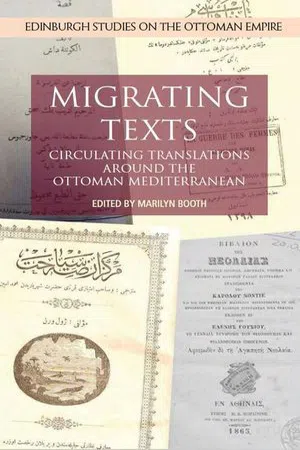![]()
PART I. TRANSLATION, TERRITORY, COMMUNITY
The chapters in this section maintain the broad focus of the Introduction but each scrutinises an intercultural, interlinguistic field differently. In ‘What was (really) translated in the Ottoman Empire? Sleuthing nineteenth-century Ottoman translated literature’, Johann Strauss approaches the history of translation obliquely, through the ways translation happened but was misnamed, mis-identified or subsumed in massive projects of comPilation. For instance, Şemseddin Sami’s encyclopedic
Kamusü l-alam (1889–98), an important conduit for knowledge transmission amongst late-nineteenth-century Ottomans, must be reconsidered as in large measure a translation, but from multiple sources. Although one could read these misattributions as a history of scholarly and cartographic ‘error’, they become a means by which to think about both what was translated and how texts and authors were presented to readers. And the scholar’s task becomes one of sleuthing: lurking in unexpected places, looking for odd clues. The ways that translation is
not defined tells us about attitudes toWards translation, as an act that was not necessarily regarded as secondary authorship. If the translator’s name is not mentioned, what does this mean? As Strauss argues, it is difficult to evaluate
Robinson Crusoe’s reception among the Ottoman reading public if we do not establish which version was actually translated into Turkish. Without a closer look, we cannot gauge what these ‘translations’ actually conveyed about authors famous elsewhere. Strauss’s approach warns against premature conclusions about the contents and vectors of knowledge transmission, and explores points raised in the Introduction about the blurry boundaries of ‘translation’. how might a closer look at misattribution and misappropriation urge the revision of established canons of translated literature? And what might it tell us about studying translation historically, as sleuths and spies, examining our odd and incomplete archives by trying to put ourselves in the places of translators then?
Strauss’s microscopic scrutiny of the Ottoman translation scene is followed by Peter Hill’s telescopic gaze at translation across the world since the seventeenth century. ‘Translation and the globalisation of the novel’ reconnoiters the diffusionist model of literary translation made famous by Franco Moretti. Hill graphs the spread of some particularly ‘best-translating’ novels over the length and breadth of the Mediterranean coasts and far beyond, A ‘distant reading’ of how works such as Fénelon’s Télémaque and Defoe’s Robinson Crusoe move from a north-west European ‘core’ through ‘semi-peripheries’ and ‘peripheries’, reveals regularities supporting Moretti’s model. Yet as an approach designed for literatures of that ‘core’, its limitations are apparent when one looks from the ‘peripheries’. Hill argues for a hybrid practice via mid-level generalisations; and he proposes testing the diffusionist model by looking at ‘secondary’ translation and diffusion from centres outside Moretti’s ‘core’, the sort of lateral transmission that this project highlights.
Orit Bashkin’s chapter focuses on a ‘national’ space in the early twentieth century only to interrogate assumptions about ‘the national’ as a concept and practice that forecloses multiplicity. ‘On Eastern cultures: Transregionalism and multilingualism in Iraq’ juxtaposes the journalistic works of Hibat al-Din al-Shahrastani and the fiction of Mahmud Ahmad al-Sayyid to challenge a national narrative holding that the Iraqi state rejected the Ottoman past and its multilingual, multi-ethnic cultures. A study of these individuals’ work counters the notion that Iraqi culture was tyPified by isolated and isolationist grouPs whose translation Practices targeted specific sectarian grouPs, and it reminds us how tightly intertWined journalism and translation have been. Al-Shahrastani’s journal
al-Ilm points to the multilingual and transnational milieu of 1910s Najaf, while al-Sayyid’s later writings underscore the survival of transregional networks. Readers depended on publications coming from Istanbul, Teheran, Cairo, Beirut and the Indian subcontinent. Al-Shahrastani and al-Sayyid seem to reside in different Worlds: a Shi
i
alim, a Sunni socialist writer of Prose fiction. But both were shaPed by Iraqi society’s mélange of cultures and languages – and the ways translation was fundamental to creating shared conversations in the Arab-Ottoman print market on modernity, colonialism, constitutionalism, nationalism and reform.
![]()
1
What was (Really) Translated in the Ottoman Empire? Sleuthing Nineteenth-century Ottoman Translated Literature
Johann Strauss
In one of our major bibliographical sources for works published in Ottoman Turkish, Seyfettin Özege’s catalogue of Turkish books printed in Arabic script,1 numerous titles are listed as ‘translated from …, translated by …’ without giving any indication of the original work and its author because this information was not mentioned in the translation itself. But these are not the only problems of attribution encountered while studying translation in the nineteenth-century Ottoman Empire. Closer examination also reveals misidentifications, works whose ‘authors’ do not exist, and translations that have not been identified as ‘translations’. There are also translations whose titles were altered consciously in order to avoid problems with censorship.2 Inaccuracies and errors can be found not only in Özege’s otherwise extremely valuable catalogue but also in other works dealing with translation activity among the Ottoman Turks, in works of Turkish literary or intellectual history.3 To write the history of translation in the Ottoman Empire, one must be a bit of a sleuth and a spy, searching for clues wherever they might exist, listening through the keyholes of title pages and colophons and other texts, and at times making imaginative (if evidence-based!) connections. If translation by its nature is a rewriting, a possessing anew of a text already in the world, it is hardly surprising that writers and publishers might not always care to make the original known; or they might not know what that original is. This is a feature of the history of translation everywhere, but the present chapter narrates one scholar’s attempts through the years to track and trace one instance of it: the sometimes elusive, often meandering, paths by which texts appeared in the Ottoman Empire. Such pathways may help us think historically about how writers (translators), readers and publishers thought about translation – and how the attempts since then at ‘p...




